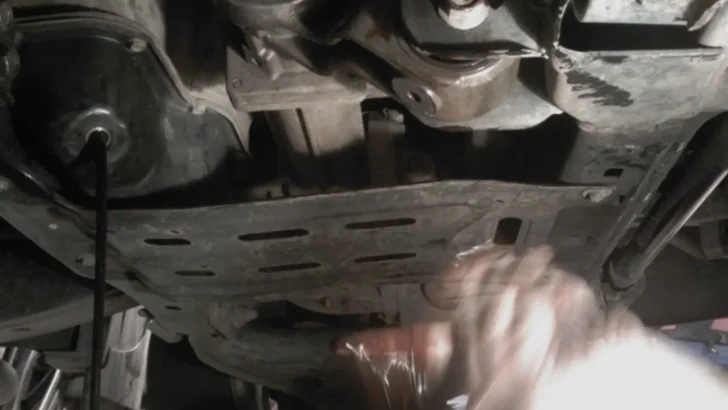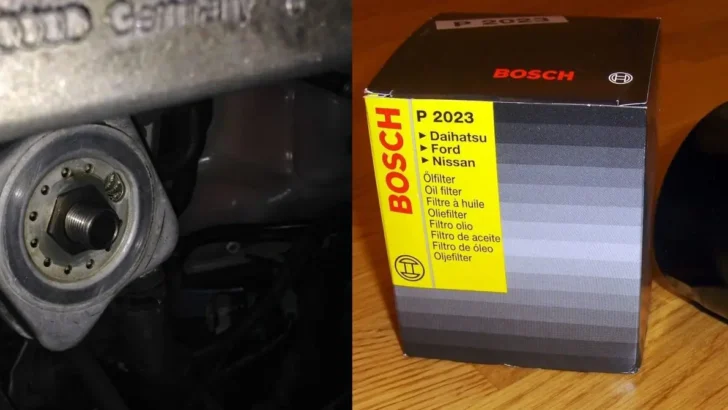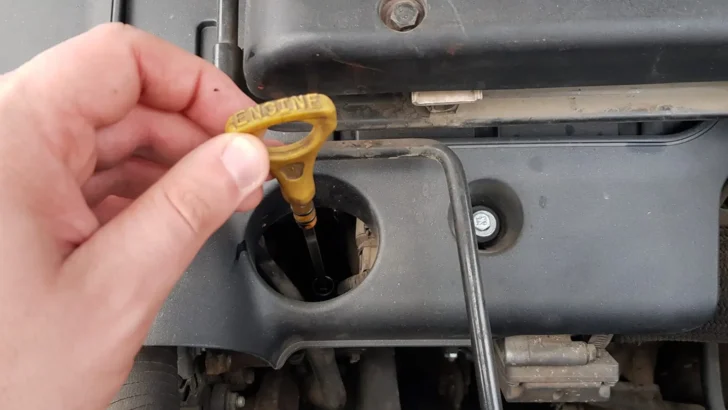Do you have a car or truck that is smoking at startup and you wish to stop it? It can be a scary experience, especially if you don’t know how to stop it.
White smoke from the exhaust can be caused by a number of reasons. However, if your car or truck is smoking only at startup, it is a completely different story.
In this blog post, we will discuss the causes of car and truck smoking, and how to stop it from happening.
Key Takeaway
- To stop your car or truck from smoking at startup, you will need to park the vehicle on a leveled ground, drain the old oil, change the oil filter, pour half of the required engine oil, add Lucas engine oil stop leak product, and then add the rest of the engine oil minus the weight of the additive.
- Vehicles that smoke on start-up has worn-out valve seals that allow engine oil to leak into the combustion chamber and get burned off with the air and fuel.
Why Does My Truck Smoke When I First Start It?

If you’ve noticed your truck smoking when you first start it up, the most likely cause is bad valve seals. When the engine is off, the oil in the cylinder drains down past the valves and into the crankcase. The oil pressure light should come on for a few seconds when you start your truck’s engine.
If it doesn’t, that means there’s not enough oil pressure to hold the valve seals up against the valves. As a result, oil leaks past the seals and into the combustion chamber, causing your truck to smoke.
A car or truck that smokes at startup has worn or damaged valve seals that allow the engine oil to leak into the combustion chamber and get burned with the air/fuel mixture. Your vehicle will smoke only at startup because as the engine warms up, the valve seals will expand and form a tight seal.
Valve seals are an important part of a car’s engine. They are located between the valves and the combustion chamber, and their purpose is to prevent oil from leaking into the combustion chamber.
Over time, valve seals can become worn or damaged, causing oil to leak into the combustion chamber and causing the car or truck to smoke at startup. Valve seals can be replaced as part of a routine maintenance schedule, and doing so can help keep your car’s engine running smoothly.
You may also notice a loss of power and decreased fuel economy. In some cases, replacing the valve seals will fix the problem. However, if the seals are excessively worn or damaged, you may need to have the valves replaced .
How to Stop a Car or Truck From Smoking at Startup

The best way to stop a car or truck from smoking at startup is done when you change the engine oil. The reason behind the smoking at startup is worn-out valve seals that contract when the engine is cold and allow for oil to enter the combustion chamber.
So, when you change the engine oil, you can add an additive that will prevent the valve seals from contracting. Here is a detailed guide on how to stop a car or truck from smoking at startup:
1. Required materials

- Lucas engine oil stop leak (see the price on amazon.com)
- Engine oil compatible with your engine (see options on amazon.com)
- An oil filter (see options on amazon.com)
- Jack and jack stands
- Oil filter wrench
- 10-millimeter socket
- Oil drain pan
2. Park the vehicle on a leveled ground

When you perform an oil change, you need to park your vehicle on leveled ground. This will ensure that all of the oil will be drained and none of the old oil will be left inside the oil pan. Also, what you have to keep in mind is that you will need to slightly jack the front of the vehicle.
So, make sure to avoid starting this procedure on soft ground because it won’t be able to support the weight of the vehicle and the jack will simply sink into the ground.
3. Apply the parking brake

This one might be obvious but I have to mention it because I see so many people forgetting to apply the parking brake when they change their oil.
Not only do I apply the parking brake, but I also go one step further and I place wheel chocks on behind the back tires. This is me just being super careful but also safe while working underneath my vehicle.
4. Open the oil filler cap

With everything in place, open the hood and locate the oil filler cap. The oil filler cap is located on top of the engine in close proximity to the oil dipstick and is often marked with ”Engine Oil”.
Removing the oil filler cap will ensure that the engine oil can be drained in the next step. When removing the oil filler cap, it is always wise to inspect it for any debris.
What I like to do at this point is really take a look at the oil cap. Look for any metal shaving, debris, or discoloration. This is going to tell you how the engine is being lubricated (if you find any metal shaving it obviously isn’t lubricated enough).
If you find any milky or gunk oil, it means that something is mixing with the engine oil and you need to look into it.
5. Jack the front end of the vehicle

Next, you need to jack the front end of the vehicle and place it on jack stands. You just need to lift the front end a little bit so you can get under the vehicle and gain access to the drain bolt. Each vehicle has different jacking points and if you are not sure where they are on your vehicle, you can check the owner’s manual.
Place the jack at the front jacking point and lift your vehicle just enough so you can position yourself under it. Then, to be safe, place the vehicle on jack stands.
6. Locate and remove the oil drain bolt

When it comes to locating and removing the oil drain bolt in a car, there are a few key things you need to keep in mind. First, you should make sure that your car is properly supported and leveled before you begin.
This will ensure that the oil flows smoothly out of the drain bolt when you remove it. I know I mentioned this before, but I just want to remind you.
To locate the oil pan get underneath your car’s engine. The drain bolt is usually located near the bottom of this pan, so take some time to look around until find it. Once you have found the drain bolt, use a wrench or socket set to loosen and remove it from its housing.
Before you remove the oil drain bolt, make sure that you have an oil drain pan in place. In fact, you want to position the oil drain pan even before you start loosening up the bolt. The old oil has to be disposed of appropriately.
Once there is no more oil dripping, reinstall the oil drain bolt and tighten it to spec. Take your time because if you do not tighten the bolt correctly, it could leak the new oil.
7. Locate and remove the oil filter

The oil filter can be found both in the engine compartment from the top side or underneath the vehicle. It really depends on your make and model. If you are unsure where the oil filter is on your vehicle, you can look the information up in the owner’s manual.
For the sake of the article, let’s say that the oil filter is on the top side and can be accessed from under the hood.
If your engine has any plastic covers, remove them so you can easily locate and remove the oil filter. Grab the oil filter wrench and start loosening it. Before you completely remove the oil filter, keep in mind that there is oil inside it. So, grab some old cloth and be prepared to wipe if any oil gets on the engine components.
8. Install the new oil filter

Before installing the new oil filter, make sure to lubricate it. On my vehicle, the oil filter is upside down and I can’t fill it with oil. But, if your oil filter is ”hanging”, you can fill it with engine oil before installing it.
In both cases, make sure to lubricate the bottom part of the oil filter that goes into the engine block. Tighten the oil filter to spec using the filter wrench. Make sure there is no oil dripping from the new oil filter.
9. Pour engine oil and the additive

At this point, you have drained the old oil, tightened the drain bolt, and installed a new oil filter. Now it is time to add the new engine oil along with the Lucas additive that stops oil leaks. According to the label, you need to add 20% of the engine capacity.
If your vehicle has the capacity to hold 5 quarts of engine oil, you need to add 4 quarts of engine oil and 1 quart of Lucas oil leak stop product.
I usually add about half of the engine oil into the oil filler. Then, I add the required amount of Lucas additive and then the remaining engine oil. This way I know that the additive and the engine oil are mixed from the beginning. When you finish, reinstall the oil filler cap.
10. Lower the vehicle and check the oil level

Lower the front end of the vehicle and let it sit for about 5 minutes. At this time, the engine oil will settle. Next, locate the oil dipstick and remove it. Wipe the oil and then put it back for about 5 seconds.
Then, remove the oil dipstick and check the oil level. If needed, you can add more engine oil. Keep in mind that the oil filter will also get filled with oil and you might need to top it off. What I also do is I would start the engine and let it run for a couple of minutes and then turn it off and wait for about 10 minutes.
What this does is it distributes the oil inside the engine and then you can check and see how things are. You can always add more engine oil if it’s needed. It takes about 100 to 150 miles of driving for the additive to work. After this, you will notice that there is no more white smoke from the tailpipe when you start your vehicle.
Is It Normal For a Car To Smoke On Startup?
It is normal for a car to smoke on startup because the valve seals are cold and allow a little bit of oil to escape into the combustion chamber where it gets burned off with the air/fuel mixture. As the engine warms up, the seals expand and form a tight seal.
When you start your car, you may notice a small amount of smoke coming from the engine. Although this may seem alarming, it’s actually quite normal. The smoke is caused by valve seals that are designed to prevent oil from leaking into the combustion chamber. As the engine warms up, the seals expand and begin to form a tight seal.
However, when the engine is cold, the seals contract, and oil can escape. This oil then burns off as the engine warms up, causing the characteristic smoke. So if you see a little bit of smoke when you start your car, don’t be alarmed – it’s perfectly normal.
The job of the valve seals is to prevent oil from leaking into the combustion chamber. They are located between the valve stems and the cylinder head, and they consist of a rubber lip that fits snugly around the valve stem.
As the engine runs, the pressure of the expanding gases pushes against the valve stems, which in turn puts pressure on the valve seals. The rubber lip prevents oil from flowing past, thus keeping it out of the combustion chamber.
Over time, however, the valve seals can become hard and brittle, which can cause them to crack and allow oil to leak past. When this happens, it can lead to increased oil consumption and smoke on startup. As a result, it is important to replace worn-out valve seals in order to keep your car running smoothly.
FAQs
Q: Can smoking at startup damage my car or truck?
A: Yes, smoking at startup can indicate underlying issues that can cause damage to your vehicle. If left untreated, it can lead to engine damage, reduced fuel efficiency, and increased emissions. It is essential to address the problem promptly to prevent further damage.
Q: Can I continue driving my car or truck if it smokes at startup?
A: It is not advisable to continue driving your vehicle if it smokes at startup. Smoking can indicate serious problems with your engine that can worsen over time. Continued driving may lead to engine damage or other costly repairs. It is best to have the issue resolved before driving the vehicle.
Q: How much does it cost to fix a car or truck that smokes at startup?
A: The cost of fixing a vehicle that smokes at startup can vary depending on the underlying cause. It can range from a simple fix, such as cleaning the fuel injectors, which can cost around $100, to more complex repairs involving replacing piston rings or valve seals, which can cost several hundred dollars or more. It is recommended to consult with a mechanic for an accurate estimate.
Q: Can I fix a car or truck that smokes at startup myself?
A: Some minor issues, such as cleaning the fuel injectors or replacing the air filter, can be done by individuals with basic automotive knowledge. However, diagnosing and fixing more complex issues, such as worn-out piston rings or faulty valve seals, require specialized tools and expertise. It is best to consult with a professional mechanic for proper diagnosis and repair.
Q: Is smoking at startup a normal occurrence for older vehicles?
A: While some older vehicles may experience more smoke at startup due to general wear and tear, it is not considered normal or healthy for a vehicle to smoke excessively. Excessive smoking can indicate underlying problems that require attention to prevent further damage to the engine.
Q: Should I be concerned if my car or truck only smokes on cold starts?
A: Smoking on cold starts can be attributed to several factors, such as condensation in the exhaust system or fuel-rich mixture during startup. While it may not always indicate severe problems, it is advisable to have a professional mechanic inspect the vehicle to rule out any issues that may require attention.
Q: Can using additives or fuel treatments stop my car or truck from smoking at startup?
A: In some cases, certain fuel additives or treatments can help reduce smoking at startup. These additives may help clean the fuel system and improve combustion, leading to reduced smoke emissions. It is best to consult with a mechanic or follow the manufacturer’s instructions before using any additives or treatments in your vehicle.
Q: Is smoking at startup always an indication of a serious problem?
A: While smoking at startup can indicate serious problems, it may not always be the case. Sometimes, minor issues such as a clogged PCV valve or excessive oil residue in the combustion chamber can cause temporary smoke during startup. However, if the smoking persists or worsens, it is recommended to have the vehicle inspected by a professional mechanic.
In Conclusion
In conclusion, stopping a car or truck from smoking at startup involves various steps ranging from regular maintenance to addressing specific issues.
These can include changing the oil regularly, replacing worn-out gaskets, and repairing any coolant leaks.
It’s important to remember that smoke at startup is often a sign of underlying mechanical issues, and ignoring these signs can lead to more serious problems down the line.
